This was published 2 years ago
‘This war is sadism’: the battle to survive in the ruins of Kharkiv
In the ruins of Ukraine’s second-largest city, those who remain behind are determined to carry on. Anthony Galloway and Kate Geraghty report from Kharkiv.
By Anthony Galloway and Kate Geraghty
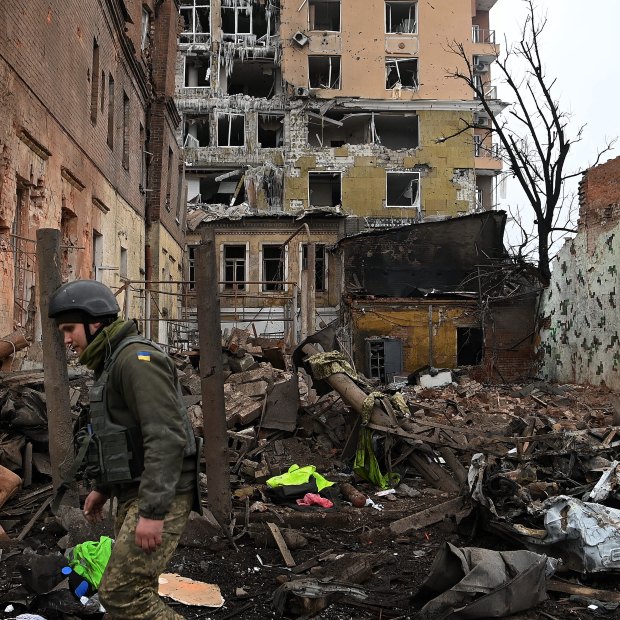
Ukrainian soldier walks past damaged buildings caused by an air strike that hit the military police building in the city centre of Kharkiv.Credit: Kate Geraghty
Galyna Rasstanna couldn’t run to take cover when her apartment block was hit by a Russian airstrike.
The 86-year-old lifelong Kharkiv resident is frail and can no longer walk. So, she just lay there.
Her daughter was seriously injured in the attack on February 27, but she can’t visit her in hospital. Rasstanna desperately wants to get out of her building now but she can’t.
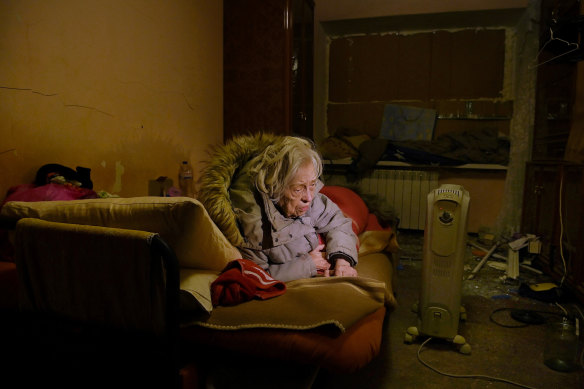
Unable to walk, Galyna Rasstanna, 86, lies in her bed and weeps and begs for the shelling to stop. Credit: Kate Geraghty
The Russian air force was targeting a nearby military school in the Kholodna Hora area in the city’s west, and Rasstanna’s five-storey Soviet-style apartment block was collateral damage. Rasstanna’s apartment on one of the top floors was practically destroyed, so the owner of the orange-brick building has moved her down to an apartment on the ground floor.
Entering the one-bedroom apartment through a midget hallway, the Russian-speaking white-haired Rasstanna summoned the strength to lift her head up from her mattress on the ground before delivering a single plea: “Please stop this war,” she told us, crying. “This war is sadism at the expense of civilians.”
She seemed to only have enough energy for one cry for help at a time, before receding back under her blankets as she braced from the bitterly cold weather which failed to reach zero degrees.
Asked what her message was for the Russians who attacked her home, she said: “I don’t care who is shelling, but whoever they are – they are shelling us.”
“In Kharkiv, there are mainly Russians... I don’t know why this is happening.”
Kharkiv is in north-eastern Ukraine, a 45-minute drive from the Russian border. Its residents are predominantly Russian-speaking. It is precisely the type of community Vladimir Putin claims to be liberating from Ukraine.
On the streets, it is clear that Putin’s troops have not come to liberate the city, but to destroy it.
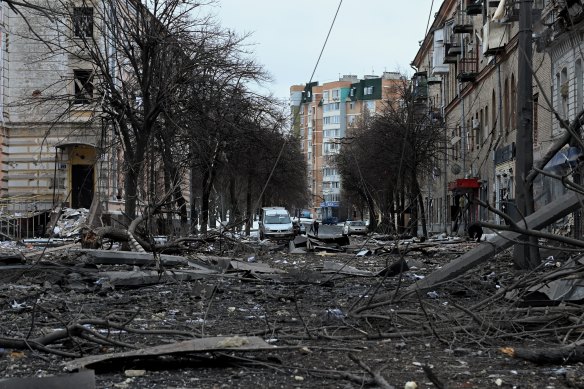
A bomb aimed at military police building in the city centre of Kharkiv also levelled nearby apartments and a park. Credit: Kate Geraghty
In the centre of the snow-covered city on Novobavarskyy Avenue, a rocket attack on Sunday night reduced a city block to a bombed-out wasteland. The Russians were targeting a military police centre, but civilian buildings, cars and an adjacent park were wiped out. At least eight buildings were hit.
On Monday, ash still filled the air as Ukrainian soldiers began shovelling the rubble out from the ruins. The remnants of a car, desks and chairs lay waste in an eight-metre-wide crater carved out by one of the bombs. The park, too, is cratered and choked with dust like a moonscape.
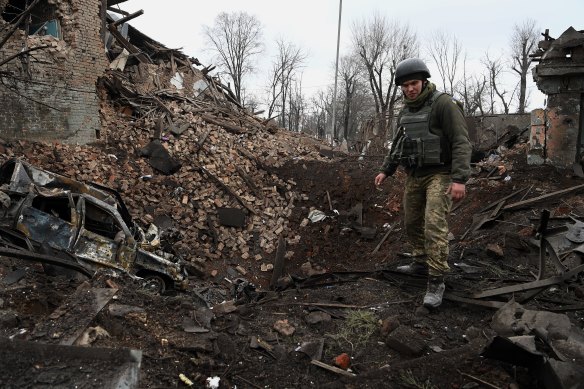
A Ukrainian soldier stands at the edge of an eight-metre crater where people once lived. Credit: Kate Geraghty
A man who lives across the road said he saw the aftermath of the air strike from his window.
“It was like a great sound and then fire. I saw fire from my window,” he said.
“I don’t know if we will be able to recover from this problem in the next 10 or 20 years. I don’t know how this can continue.”
For anyone with a cursory knowledge of modern military capabilities, one of the first things that draws attention amid the desolation of Kharkiv is the lack of precision that has been shown. Instead of guided missiles, the Russians are dropping what the military call “dumb bombs” – bombs that simply rely on their freefall trajectory to wreak maximum destruction.
And they are big.
The Russians may have landed a direct hit on the military police centre, but they also destroyed the nearby buildings and flattened the urban park.
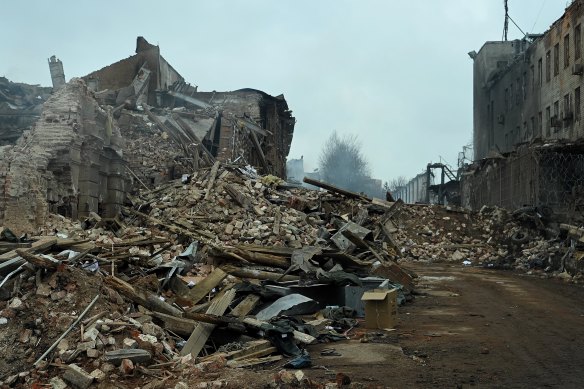
The destruction is evidence the Russians are using “dumb bombs” for wanton destruction, not guided missiles for precision strikes.Credit: Kate Geraghty
There are also reports that Russia has been using cluster munitions – rockets or missiles that deploy a large number of small explosives that scatter over wide areas. However, we found no evidence of this on Monday.
In other parts of Ukraine, the highways are banked up for days with people trying to leave. But the road between Dnipro and Kharkiv is not busy. You get a sense here that those who want to flee, already have. The train station is no longer crushed with people as it was on the first day.
During the day, those who have decided not to flee this besieged city freely walk the streets to get their groceries and go to work, while many volunteer to help aid the war effort.
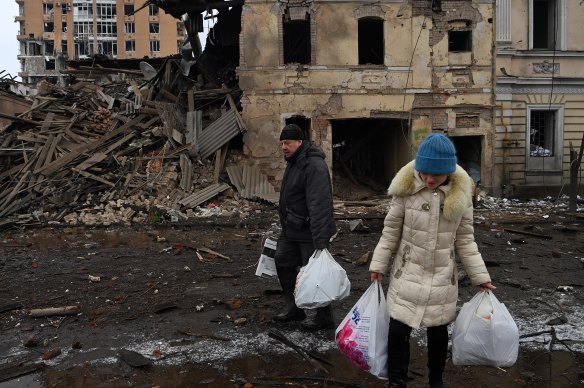
Residents carry bags of what they could salvage from their building, destroyed by an air strike.Credit: Kate Geraghty
On its Telegram account, the city council posts alerts about local athletes at the Paralympics, where to find functioning ATMs and the challenges of repairing water leaks in buildings where the residents have fled, taps running and doors locked. In the streets, crews work to repair powerlines, and shops, somehow, reopen.
The residents who stayed are fatigued and scared, but insist they are here for the long haul.
Back in the west of the city, a Russian air strike completely wiped out a factory, ravaged a building across the road and damaged a nearby hospital.
Volodymyr Bratslavets, who lives in the partially destroyed building, said he watched six of his neighbours die in the attack. He estimates 20 people were killed.
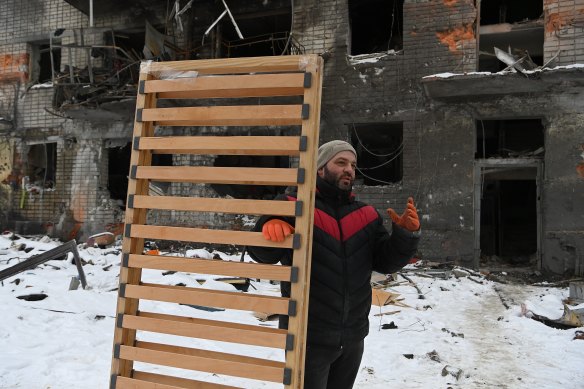
Volodymyr Bratslavets watched six of his neighbours die in an attack. Now he looks for somewhere else to sleep. Credit: Kate Geraghty
Carrying out a bed frame from his wiped-out apartment, the 40-year-old said he believed four bombs in total were dropped in the attack on March 1.
“Two bombs hit the factory, the third one hit somewhere between, and the fourth one hit close to my building,” Bratslavets said.
“Why was this factory a target? There might have been some construction of military vehicles. But it was a factory making cranes, and I thought it hadn’t been in operation since before Ukraine had its independence – more than 30 years ago.”
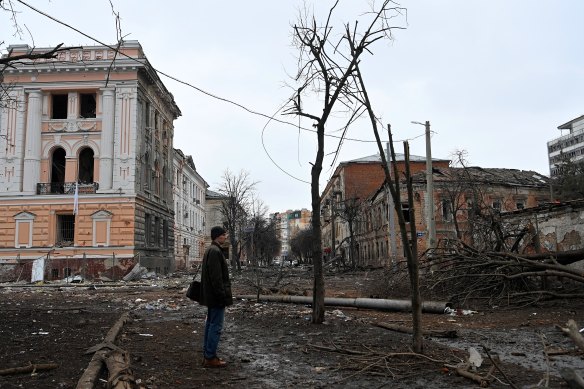
Those who stayed in Kharkiv head outside between Russian attacks and try to continue their daily life. Credit: Kate Geraghty
But Bratslavets isn’t leaving. He drags his bed frame from the ruins to take to another place to sleep.